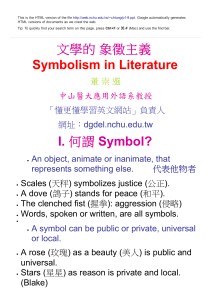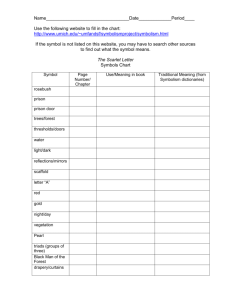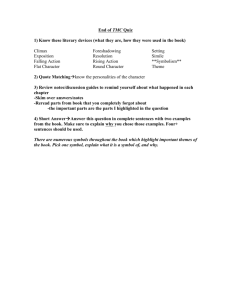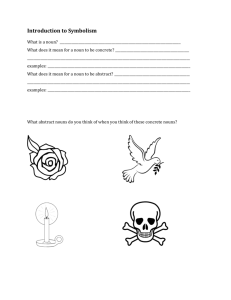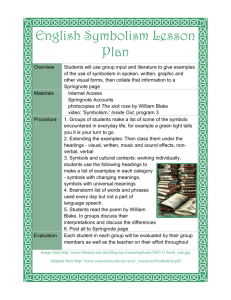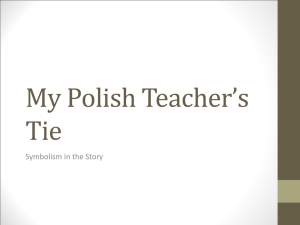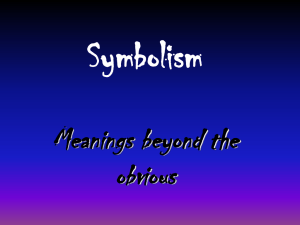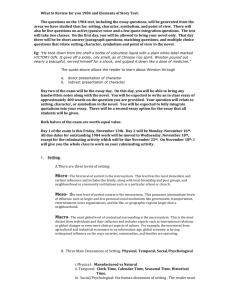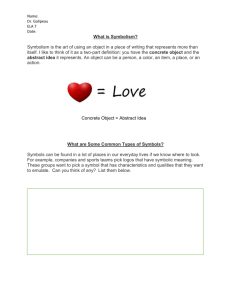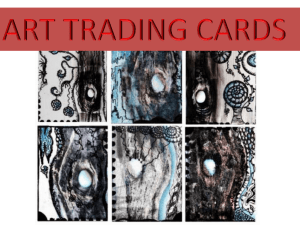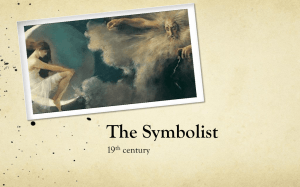演講綱要
advertisement
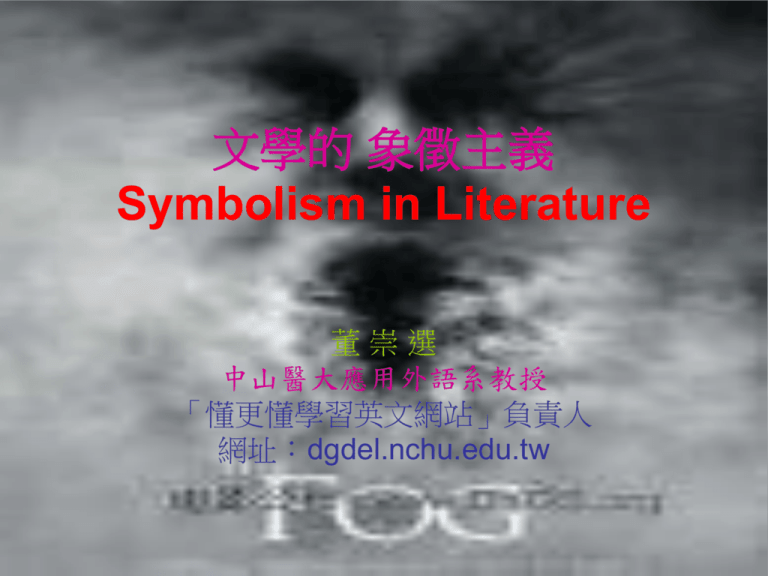
文學的 象徵主義 Symbolism in Literature 董崇選 中山醫大應用外語系教授 「懂更懂學習英文網站」負責人 網址:dgdel.nchu.edu.tw I. 何謂 Symbol? – • • • • • Scales (天秤) symbolizes justice (公正). A dove (鴿子) stands for peace (和平). The clenched fist (握拳): aggression (侵略) Words, spoken or written, are all symbols. – • • An object, animate or inanimate, that represents something else. 代表他物者 A symbol can be public or private, universal or local. A rose (玫瑰) as a beauty (美人) is public and universal. Stars (星星) as reason is private and local. (Blake) I. 何謂 Symbol? – • The lily (百合花) vs. purity (清純): white & clean – • A symbol involves comparison like simile or metaphor. A symbol is not so definite in meaning as an allegory. Christian (基督徒) passes through the Slough of Despond (沮喪之沼澤) and Vanity Fair (虛榮市集) and arrives at the Celestial City (天國之城). --Allegory in Bunyan’s Pilgrim’s Progress. • Gregor finds himself turned into a big cockroach (蟑螂). --Symbol in Kafka’s Metamorphosis. II. Symbolism as a Movement: – Primarily in literature (esp., poetry), also in other arts. (見畫) – Beginning in France in the latter part of the 19th C. – A movement against Realism and Naturalism. 反寫實 – Moréas’s manifesto: “le Symbolisme” • To clothe the idea in perceptible form. • 以 可覺知的形式 衣著觀念。 “The Death of the Gravedigger” by Schwabe Khnopff’s “The Caress” II. Symbolism as a Movement: – Influenced by Swedenborg’s theory of correspondences (對應論) and Schopenhauer’s pessimistic aesthetics (悲觀美學). • There are correspondences between the natural ( physical), the spiritual, and the divine worlds. • We are ever living with sufferings under the Will-to-life, and Art serves as a contemplative refuge (思想的庇護) from the world of Will. III. Key Ideas of Symbolism: – Using concrete images (具象) as symbols (象徵) to express an emotion or an abstract idea, to represent an ideal world, or to suggest another plane of reality (實体面). – The poet is a kind of seer (先知) or voyant (先覺) who could see through and beyond the real world to the world of ideal forms and essences. – Using the method of suggestion (提示) to evoke (喚起) hidden meanings. III. Key Ideas of Symbolism: – The world of essences is a world of synesthesia (fusion of sensations, 共感). – To achieve pure poetry (純粹詩) through word relationships: musical quality (言樂性), image clusters (意象群), logical and psychological associations (聯想). – The best form is free verse (vers libres 自由 詩), or “prose poem” (散文詩). IV. 一些名言: • “The sun itself is the dark simulacrum (影 像), and light is the shadow of God.” --Sir Thomas Brown • “Symbolism is the art of evoking an object little by little so as to reveal a mood (心境)” or, conversely, “the art of choosing an object and extracting from it an état d’âme. (心境).” --Mallarmé IV. 一些名言: • “The only way of expressing emotion in the form of art is by finding an ‘objective correlative’ (相 關客体); in other words, a set of objects, a situation, a chain of events which shall be the formula of that particular emotion; such that when the external facts, which must terminate in sensory experience, are given, the emotion is immediately evoked.” --T. S. Eliot • 「門前遲行跡,一一生綠苔;苔深不能掃, 落葉秋風早。八月蝴蝶黃,雙飛西園草。」 李白〈長干行〉 V. 重要作家作品: • Baudelaire: The Flowers of Evil 波德萊 (《惡之華》) 〈對應〉 “Correspondences” 〈鬱卒 78〉 “Spleen LXXVIII” “Windows” (prose poem) • Mallarmé: • Rimbaud: • Verlaine: Correspondences Nature is a temple whose living colonnades Breathe forth a mystic speech in fitful sighs; Man wanders among symbols in those glades Where all things watch him with familiar eyes. Like dwindling echoes gathered far away Into a deep and thronging unison Huge as the night or as the light of day, All scents and sounds and colors meet as one. Perfumes there are as sweet as the oboe’s sound, Green as the prairies, fresh as a child’s caress, --And there are others, rich, corrupt, profound And of an infinite pervasiveness, Like myrrh, or musk, or amber, that excite The ecstasies of sense, the soul’s delight. Spleen LXXVIII Old Pluvius, month of rains, in peevish mood Pours from his urn chill winter’s sodden gloom On corpses fading in the near graveyard, On foggy suburbs pours life’s tedium. 鬱卒 冬雨倒冷甕 墳屍消退中 乖戾陰霾下 郊霧生長冗 My cat seeks out a litter on the stones, 孤貓露疥癬 Her mangy body turning without rest. 覓窩青瓦片 An ancient poet’s soul in monotones 詩人長凍瘡 Whines in the rain-spouts like a chilblained ghost. 獨吟雨管間 A great bell mourns, a wet log wrapped in smoke 樓鐘悲嗚燃溼木 Sings in falsetto to the wheezing clock, 壁鐘感冒猛嘀咕 While from a rankly perfumed deck of cards 發臭香牌煙幕裡 (A dropsical old crone’s fatal bequest) 水腫老嫗遺留物 The Queen of Spades, the dapper Jack of Hearts 黑桃紅心后與魔 Speak darkly of dead loves, how they were lost. 死情暗處猶傾訴 Windows Looking from outside into an open window one never sees as much as when one looks through a closed window. There is nothing more profound, more mysterious, more pregnant, more insidious, more dazzling than a window lighted by a single candle. What one can see out in the sunlight is always less interesting than what goes on behind a windowpane. In that black or luminous square life lives, life dreams, life suffers. Across the ocean of roofs I can see a middle-aged woman, her face already lined, who is forever bending over something and who never goes out. Out of her face, her dress, and her gestures, out of practically nothing at all, I have made up this woman’s story, or rather legend, and sometimes I tell it to myself and weep. If it had been an old man I could have made up his just as well. And I go to bed proud to have lived and to have suffered in some one besides myself. Perhaps you will say “Are you sure that your story is the real one?” But what does it matter what reality is outside myself, so long as it has helped me to live, to feel that I am, and what I am? VI. Influences of Symbolism: • • • • • • • • Maeterlinck: plays Proust: novel (Remembrance of Things Past) Yeats: poems T. S. Eliot: The Waste Land O’Neill: The Hairy Ape Melville: Moby Dick Pound: poems 其他國家許多人包括 painting, music, cinema, etc. VII. Conclusions about Symbolism: – – – – It is a revival of the Romantic emphasis on the visionary (靈視的). It is a re-assertion of Platonic or Neoplatonic (新柏 拉的) ideas. It is originally a French movement in poetry, but it becomes a universal (普遍的) movement in all kinds of art. It is linkable to many previous writers and later movements or techniques of art such as Imagism (意象派), Expressionism (表現主義), surrealism (超 寫實主義), and Impressionism (印象派).
